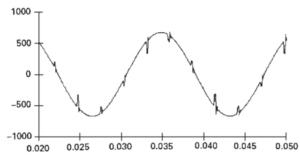Table of Contents
ToggleWhat is Waveform Distortion?
Waveform distortion is defined as a steady-state deviation from an ideal sine wave of power frequency principally characterized by the spectral content of the deviation.
There are five primary types of waveform distortion:
DC offset
Harmonics
Interharmonics
Notching
Noise
DC offset
The presence of a dc voltage or current in an ac power system is termed dc offset. This can occur as the result of a geomagnetic disturbance or asymmetry of electronic power converters.
Incandescent light bulb life extenders, for example, may consist of diodes that reduce the rms voltage supplied to the light bulb by half-wave rectification. Direct current in ac networks can have a detrimental effect by biasing transformer cores so they saturate in normal operation. This causes additional heating and loss of transformer life. Direct current may also cause the electrolytic erosion of grounding electrodes and other connectors.
Harmonics
Harmonics are sinusoidal voltages or currents having frequencies that are integer multiples of the frequency at which the supply system is designed to operate (termed the fundamental frequency; usually 50 or 60 Hz).
Periodically distorted waveforms can be decomposed into a sum of the fundamental frequency and the harmonics. Harmonic distortion originates in the nonlinear characteristics of devices and loads on the power system. Harmonic distortion levels are described by the complete harmonic spectrum with magnitudes and phase angles of each individual harmonic component. It is also common to use a single quantity, the total harmonic distortion (THD), as a measure of the effective value of harmonic distortion.
Many adjustable-speed drives will exhibit high THD values for the input current when they are operating at very light loads. This is not necessarily a significant concern because the magnitude of harmonic current is low, even though its relative distortion is high.
Interharmonics
Voltages or currents having frequency components that are not integer multiples of the frequency at which the supply system is designed to operate (e.g., 50 or 60 Hz) are called interharmonics.
They can appear as discrete frequencies or as a wideband spectrum. Interharmonics can be found in networks of all voltage classes. The main sources of interharmonic waveform distortion are static frequency converters, cycloconverters, induction furnaces, and arcing devices. Power line carrier signals can also be considered as interharmonics. Since the first edition of this book, considerable work has been done on this subject. There is now a better understanding of the origins and effects of interharmonic distortion. It is generally the result of frequency conversion and is often not constant; it varies with load. Such interharmonic currents can excite quite severe resonances on the power system as the varying interharmonic frequency becomes coincident with natural frequencies of the system. They have been shown to affect power-line-carrier signaling and induce visual flicker in fluorescent and other arc lighting as well as in computer display devices.
Notching
Notching is a periodic voltage disturbance caused by the normal operation of power electronic devices when current is commutated from one phase to another.
Since notching occurs continuously, it can be characterized through the harmonic spectrum of the affected voltage. However, it is generally treated as a special case. The frequency components associated with notching can be quite high and may not be readily characterized with measurement equipment normally used for harmonic analysis.
Figureshows an example of voltage notching from a three-phase converter that produces continuous dc current. The notches occur when the current commutates from one phase to another. During this period, there is a momentary short circuit between two phases, pulling the voltage as close to zero as permitted by system impedances.

Noise
Noise is defined as unwanted electrical signals with broadband spectral content lower than 200 kHz superimposed upon the power system voltage or current in phase conductors, or found on neutral conductors or signal lines.
Noise in power systems can be caused by power electronic devices, control circuits, arcingequipment, loads with solid-state rectifiers, and switching power supplies. Noise problems are often exacerbated by improper grounding that fails to conduct noise away from the power system.
Basically, noise consists of any unwanted distortion of the power signal that cannot be classified as harmonic distortion or transients. Noise disturbs electronic devices such as microcomputer and programmable controllers. The problem can be mitigated by using filters, isolation transformers, and line conditioners.

https://virtual-local-numbers.com/countries/1245-uae-toll-free-numbers.html
Pingback: What is UPS, Types of UPS and selection of UPS and Battery bank
To think only!
Thank you. Excellent information.
casino slot machines play online free https://findscasino.info/review-mybookie/ sc casinos online no deposit bonus
Good material. With thanks!
online casino auszahlungsquote https://combatcasino.info/review-lucky-tiger/ legal online casinos in south africa
http://maxima.2ua.in.ua/viewtopic.php?f=3&t=7597
https://anotepad.com/notes/r9ngdnhm
https://bio.site/roscarcz
Pretty! This was an extremely wonderful article.
Thank you for supplying this info.
Good post. I learn something totally new and challenging on sotes I stumbleupon every day.
It will always be exciting to read through content
from other authors andd use a little something from their web sites. http://boyarka-inform.com/